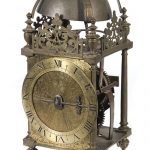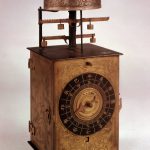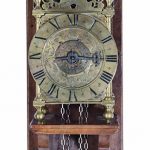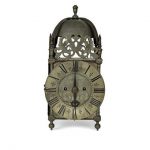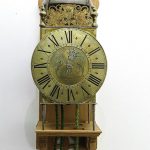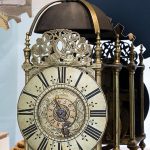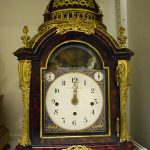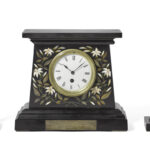Lantern Clocks. A lantern clock is a type of antique weight-driven wall clock, shaped like a lantern. They were the first type of clock widely used in private homes. They probably originated before 1500 but only became common after 1600 and in Britain around 1620. They became obsolete in the 19th century. Reference: Wikipedia.
Below are some examples and price guides to antique lantern clocks.
An important ‘First Period’ brass lantern clock William Bowyer, Leadenhall Street, London. Originally bought by John, 6th Earl of Rothes, possibly in 1626. The frame: The brass posted frame surmounted by a large bell cast with an integral lug for suspension through the centre of the brass X-frame support, (the interior of the bell with possible indistinct bell-founders mark?), the strap with chamfered edges and terminals set with pins locating into each of the four boldly turned squat urn finials mounted on tapering Doric columns on ribbed acorn feet, the pierced brass front fret signed along its lower edge ‘JOHNNE EARLE OF ROTHESS’, with matching (unsigned) side frets. (Side doors and backplate now lacking) The dial: The Roman chapter ring 6 inches in diameter and 7/8ths of an inch in width, with single line border framing the narrow numerals around a quarter hour track with star half hour markers, with pierced iron hand, the dial centre engraved with six panels of interlaced foliage separated by smaller tapering sections of engraved stylised wheatear spikes, the corners shaped to fit the profile of the pillar capitals, bases and decorated with shaded leaves, signed along the lower edge ‘William Bowyer in Ledenhall Street fecit’, the last word running upwards into the corner. The movement: The weight-driven movement with separate going and striking trains mounted one behind the other, each of three brass wheels with four crossings on steel arbors, the verge escapement to a plain brass single-armed balance, the strike train operated via an iron countwheel mounted to the rear, it’s locking detent pivoted in a raised part of the cast rear crosspiece and dropping into a filed-back recess, typical of the early Bowyer/Harvey/Stevens workshops, the hammer counter is plain with a chamfered edge, the hammer spring plain and tapered. To the top of the lug 34cms (13ins) high.
Sold for £ 43,812 inc. premium at Bonham’s in 2019
Lantern clock; steel movement; strike; double foliot; alarm; revolving hand; lacquered chapter-ring and calendar aperture; engraved brass case. Production place Made in: Japan
Reference: © The Trustees of the British Museum
AN ENGLISH BRASS LANTERN CLOCK, 19TH CENTURY, inscribed ‘THOMAS WHEELER NEAR THE FRENCH CHURCH LONDON MA’; on a later mahogany bracket 13in. (33cm.) high
Sold for USD 2,750 at Christie’s in 2015
George II Brass and Steel Lantern Clock John Smorthwaite, Colchester, circa 1730 The chapter ring with Roman numerals, surmounted by a bell, with a four pillar anchor escapement movement. Height 13 1/2 inches (34.3 cm), width 6 inches (15.2 cm), depth 6 inches (15.2 cm). The Collection of Hugh J. Grant and Lucie
Sold for $1,875 (includes buyer’s premium) at Doyle New York in 2009
An Exceptional Signed French Lantern Clock
Signed Plagsiardet a Pontau, 1728, with gong and percussion, rare in size with a height of 61 cm.
Sold for €5,000 at Veilinghuis de Jager in 2019
Lantern clock, brass, John Andrews and Co. London, England, c. 1695
Reference: Museum of Applied Art and Sciences
